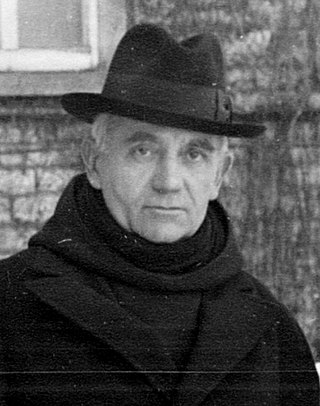
An abbey is a type of monastery used by members of a religious order under the governance of an abbot or abbess. Abbeys provide a complex of buildings and land for religious activities, work, and housing of Christian monks and nuns.

Paul Louis Denis Bellot was a French monk and modern architect.

Cluny Abbey is a former Benedictine monastery in Cluny, Saône-et-Loire, France. It was dedicated to Saint Peter.
The Cluniac Reforms were a series of changes within medieval monasticism of the Western Church focused on restoring the traditional monastic life, encouraging art, and caring for the poor. The movement began within the Benedictine order at Cluny Abbey, founded in 910 by William I, Duke of Aquitaine (875–918). The reforms were largely carried out by Saint Odo and spread throughout France, into England, and through much of Italy and Spain.

The Basilica of Notre-Dame de Fourvière is a minor basilica in Lyon, France. It was built with private funds between 1872 and 1896 in a dominant position overlooking the city. The site it occupies was once the Roman forum of Trajan, the forum vetus, thus its name.

Dijon Cathedral, or the Cathedral of Saint Benignus of Dijon, is a Roman Catholic church located in the town of Dijon, Burgundy, France, and dedicated to Saint Benignus of Dijon. The Gothic cathedral building, constructed between 1280 and 1325, and dedicated on 9 April 1393, is a listed national monument.

Liesse-Notre-Dame is a commune in the Aisne department in Hauts-de-France in northern France. In the Middle Ages, the village near Laon developed around the cult of the Black Virgin, known as Notre-Dame de Liesse. Pope Pius IX granted the Marian image a decree of canonical coronation on 18 August 1857.

Located at 6, rue Notre-Dame-des-Victoires, in the 2nd arrondissement of Paris, The Basilica of Notre-Dame-des-Victoires is one of ten minor basilicas located in the Île-de-France region of France. It was begun as an Abbey church, and constructed between 1629 and 1740 in the French classical style. Its name was given by King Louis XIII, who dedicated it to his victory over the Protestants at La Rochelle in 1628 during the French Wars of Religion. Notre-Dame-des-Victoires is famous for the ex voto offerings left there by the faithful. Over 37,000 devotional plaques, silver and gold hearts, as well as military decorations, have been left at the basilica. The closest Métro station is 'Bourse'.

Jungholtz is a commune in the Haut-Rhin department in Grand Est in north-eastern France.

St. Matthias' Abbey is a Benedictine monastery in Trier, Rhineland-Palatinate, Germany.

The Basilica of St. Martin is a Roman Catholic basilica dedicated to Saint Martin of Tours, over whose tomb it was built. It is located in Tours, France.

The Basilica of the Sacred Heart of Paray-le-Monial, commonly known as Basilica of Paray-le-Monial, is a Romanesque church dedicated to the Sacred Heart of Jesus, in Paray-le-Monial, Bourgogne-Franche-Comté, eastern France. It is a popular landmark and one of the most visited religious site in France. The Sacred Heart of Jesus was an increasingly popular devotion since the visions of Saint Margaret Mary Alacoque (1647-1690).

St. James Priory, also known as Derby Cluniac Priory, was a Benedictine monastery, formerly located in what is now Derby City Centre. It existed until the Dissolution of the Monasteries.

Souvigny Priory, in the commune of Souvigny, Allier, France, in the centre of the old province of the Bourbonnais, was formerly a Cluniac priory, of which the church remains in operation.

The Basilica of Notre-Dame d'Alençon is a Gothic parish church located in Alençon, Orne, France. It was elevated to the rank of minor basilica by Pope Benedict XVI in 2009.

The Basilique Notre Dame du Bon Secours, Marie Auxiliatrice is a Roman Catholic minor basilica in Bonsecours near Rouen, Seine—Maritime, France. It is the first church in France to be built in the Gothic Revival style. The basilica is highly ornately decorated with windows, sculptures and other elements often carrying the name or coat of arms of a patronal donor.

Romanesque architecture appeared in France at the end of the 10th century, with the development of feudal society and the rise and spread of monastic orders, particularly the Benedictines, which built many important abbeys and monasteries in the style. It continued to dominate religious architecture until the appearance of French Gothic architecture in the Île-de-France between about 1140 and 1150.

The Basilica of Notre-Dame, Marienthal, is a Catholic pilgrimage church dedicated to Mary, mother of Jesus. Located in Marienthal, in the Bas-Rhin department of France, it is administratively situated in the town of Haguenau.

The church of Notre-Dame-des-Vertus is a Roman Catholic church in Aubervilliers, Seine-Saint-Denis, France. It is listed as a Historic Monument.




















